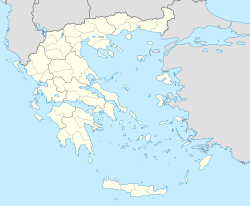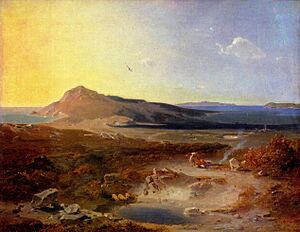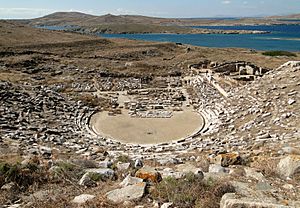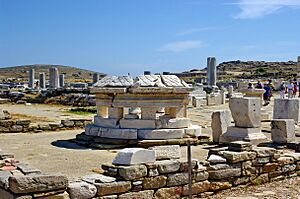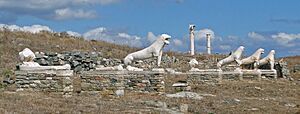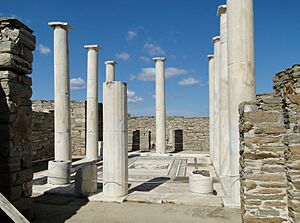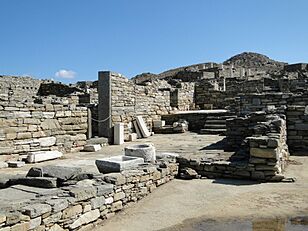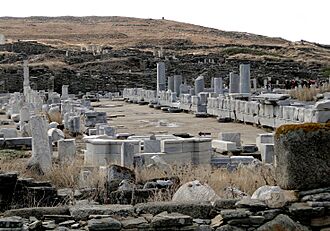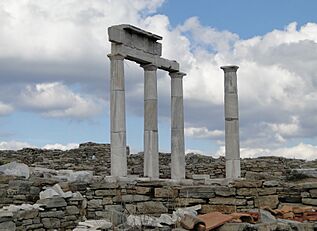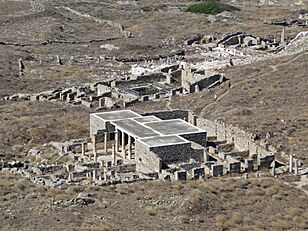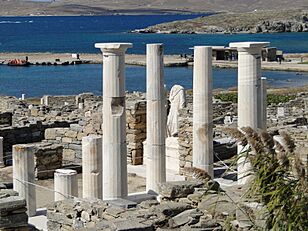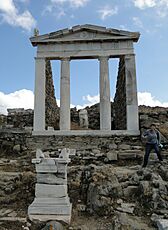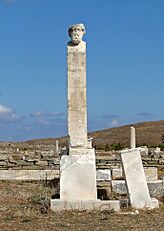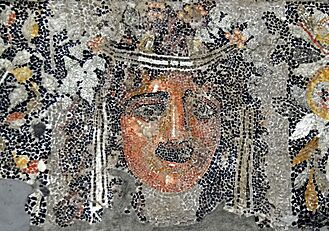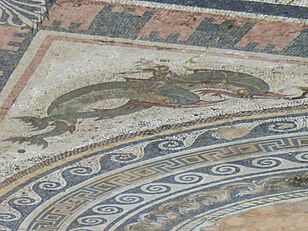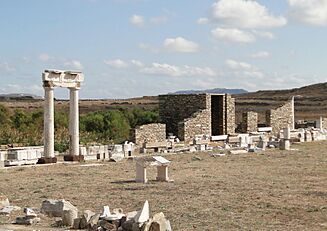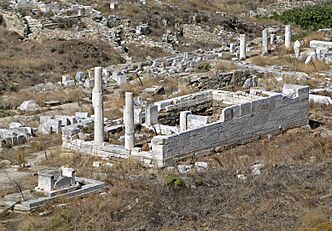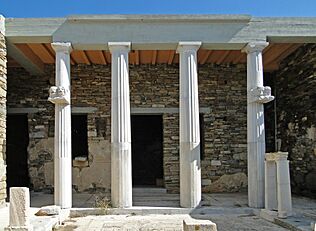Delos facts for kids
|
Native name:
Δήλος
|
|
|---|---|
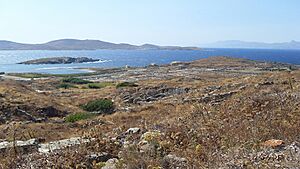
General view of Delos
|
|

Delos (on the right) and Rineia in the Cyclades
|
|
| Geography | |
| Coordinates | 37°23′36″N 25°16′16″E / 37.39333°N 25.27111°E |
| Archipelago | Cyclades |
| Area | 3.43 km2 (1.32 sq mi) |
| Highest elevation | 112 m (367 ft) |
| Highest point | Mt. Kynthos |
| Administration | |
|
Greece
|
|
| Region | South Aegean |
| Regional unit | Mykonos |
| Demographics | |
| Population | 24 (2011) |
| Pop. density | 6,8 /km2 (176 /sq mi) |
| UNESCO World Heritage Site | |
| Criteria | Cultural: ii, iii, iv, vi |
| Inscription | 1990 (14th Session) |
The island of Delos (pronounced DEE-los), located near Mykonos in the middle of the Cyclades islands, is one of the most important ancient places in Greece. It's famous for its myths, history, and amazing old buildings.
Archaeologists have done a lot of digging on Delos, finding many treasures. These discoveries are among the biggest in the whole Mediterranean region. Many of the items found are now shown in the Archaeological Museum of Delos and the National Archaeological Museum of Athens.
Delos was a very special and holy place for a thousand years. Ancient Greek mythology says it's the birthplace of the twin gods Apollo and Artemis. From its main harbor, you can see three cone-shaped hills. One of these, Mount Cynthus, has a shrine to Zeus at its top.
In 1990, UNESCO recognized Delos as a World Heritage Site. They said it's an amazing archaeological spot that shows what a big, busy port it once was. They also noted its impact on Greek architecture and its sacred importance in Ancient Greece.
Contents
History of Delos
Life in Ancient Greece
Ancient stone huts found on Delos show that people have lived there since about 3000 BC. The historian Thucydides wrote that the first people living there were Carians. They were later moved away by King Minos of Crete. By the time the Odyssey was written, Delos was already well-known as the birthplace of the twin gods, Apollo and Artemis.
From about 900 BC to 100 AD, Delos was a major religious center. People worshipped Dionysus and Leto, the mother of Apollo and Artemis, there. It became a very important place for religious pilgrimages for all Greeks, especially the Ionians.
The city of Athens performed several "purifications" to make the island even more sacred. The first was around 600 BC, led by Pisistratus. He ordered that all graves near the temple be moved to another island. Later, a rule was made that no one could be buried or born on Delos. This was to keep the island holy and neutral for trade. After this, the first Delian games, held every five years, took place.
After the Persian Wars, Delos became the meeting place for the Delian League, formed in 478 BC. This was a group of Greek city-states working together. Their shared money was also kept here until 454 BC, when Pericles moved it to Athens.
During the Hellenistic period, a group of Phoenician traders lived on the island. They had many business connections. Delos had to import all its food, cloth, and wood. It had a good system of cisterns and aqueducts to collect and move water. Different areas had their own agorae (markets).
Roman Times
Strabo wrote that in 166 BC, the Romans made Delos a free port. This helped them hurt the trade of Rhodes, which they were not friendly with at the time. After a Roman victory in 167 or 166 BC, the Roman Republic gave Delos to the Athenians. Most of the original people living there were asked to leave. Roman traders came to Delos to buy and sell many things. It became a very busy trading hub, where many different goods were exchanged, and unfortunately, people were also bought and sold.
When the Romans destroyed Corinth in 146 BC, Delos took over its role as the main trading center in Greece. However, Delos's success and population dropped a lot after attacks by Mithridates VI in 88 and 69 BC. By the end of the first century BC, trade routes had changed. Delos was no longer the main center for Italian trade with the east, and its religious importance also declined.
Even with its decline, some people still lived on Delos in the early Roman Empire. Pausanias, writing in the second century AD, said that only a few people who looked after the shrines lived there. However, evidence like Roman baths, coins, and churches from the first to sixth centuries AD show that the island was still used, even if not continuously populated. Pottery found suggests that goods like wine and oil were still brought in. Also, wine presses from this time show that people were making wine.
Delos was finally abandoned around the eighth century AD.
Famous Landmarks
- The small sacred lake was a key feature of the island. It's now kept dry to prevent mosquitoes.
- The Minoan Fountain was a public well carved into the rock. It was rebuilt in 166 BC and still has steps leading down to the water.
- Several market squares have been found. The Hellenistic Agora of the Competaliasts near the Sacred Harbour still shows holes for market awnings.
- The Temple of the Delians, dedicated to Apollo, is a great example of Doric order architecture. A giant statue of Apollo once stood next to it. Only parts of the statue remain today.
- The Terrace of the Lions was given to Apollo by the people of Naxos around 600 BC. It originally had 9-12 marble lions, guarding the Sacred Way. Today, only seven lions remain on the island.
- The Oikos of the Naxians (House of the Naxians), built in the early 500s BC, was a long hall with columns.
- The Establishment of the Poseidoniasts was a clubhouse for merchants and shipmasters from Berytian (modern-day Beirut). They worshipped their gods and also Roma.
- The Doric Temple of Isis was built on a hill. It was dedicated to the gods Isis, Serapis, and Anubis.
- The Temple of Hera, built around 500 BC, was a new version of an older temple on the same spot.
- The House of Dionysus is a fancy old house from the second century BC. It's named after a floor mosaic showing Dionysus riding a panther.
- The House of the Dolphins is named for its atrium mosaic, which shows little angels riding dolphins.
- The Stoivadeion was dedicated to Dionysus, the god of wine. It has a statue of him.
- The “Delos Synagogue” are the ruins of what was once thought to be an ancient Samaritan place of worship.
Who Lives There Now?
In 2001, the Greek census reported that 14 people lived on Delos. The island is part of the municipality of Mýkonos.
More recently, in 2011, the island had 24 inhabitants.
Gallery
See also
- Delia (festival)
- Delian problem
- History of the Cyclades


